How to Sell Digital Products on Amazon
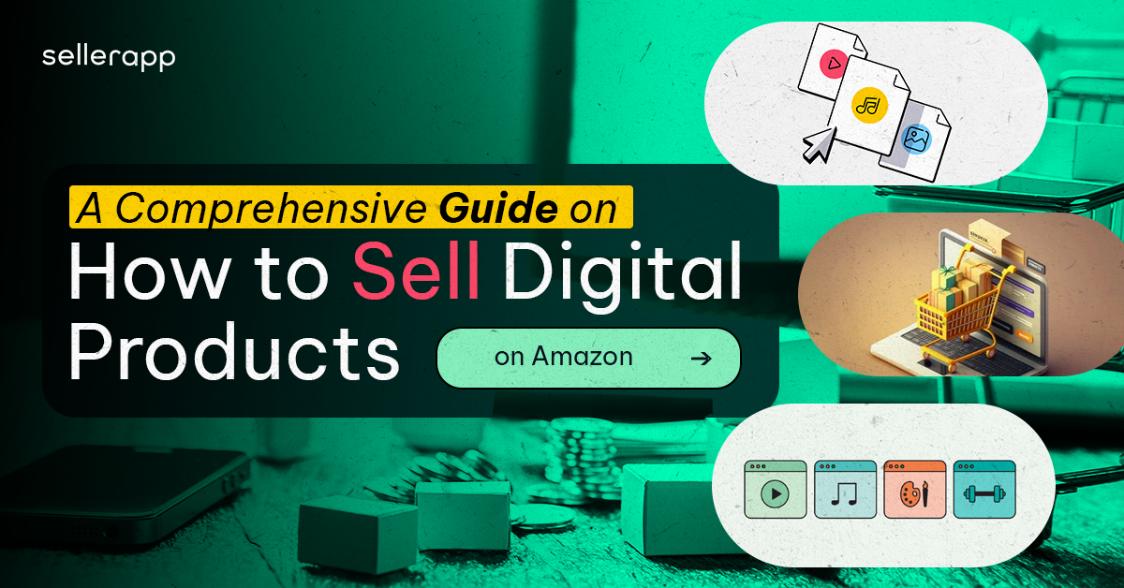
As the ecommerce landscape continues to evolve, selling digital products on Amazon has emerged as a lucrative opportunity for creators, entrepreneurs, and businesses looking to reach a global audience and generate passive income.
In this comprehensive guide, we will walk you through the process of selling digital products on Amazon, from understanding the types of digital products that can be sold to mastering the steps involved in research, creation, listing, and promotion.
So, let’s dive in and explore the best-selling digital products on Amazon!
Quick Guide
- How to Sell Digital Products on Amazon
- Best-Selling Digital Products on Amazon (How it works + pros and cons)
- Benefits of Selling Digital Products on Amazon?
- How to Be Profitable By Selling Digital Products on Amazon?
- Conclusion
How to Sell Digital Products on Amazon
Selling digital products on Amazon follows a well-structured process that can be divided into several key steps. Here are the steps for selling digital products on Amazon:
1. Research Opportunities and Ideas
Start by conducting thorough market research to know the potential opportunities and validate ideas for digital products. Understand the wide array of digital products eligible for sale on Amazon, including eBooks, graphics, music, apps, audiobooks, and video content. Amazon offers multiple avenues such as Kindle Direct Publishing (KDP), Merch by Amazon, TuneCore, and the Amazon Appstore for selling various digital products.
2. Create Your Digital Product
Develop your digital product while ensuring it meets high-quality standards and remains relevant to your target audience. Make sure that for the product that you create, you get as many people as possible to read/view/listen to. Also, start collecting feedback from those who have experienced your digital product. Make the changes to your content based on the feedback.
3. List Your Product on Amazon
Format and upload your digital product listings onto Amazon’s platform, ensuring they are readily accessible for instant download by customers. Boost visibility and attract potential buyers by optimizing your listings with relevant keywords.
4. Promote Your Listings
Use Amazon’s range of marketing tools, including sponsored ads, deals, and discounts, to effectively promote your digital product listings. Capitalize on Amazon’s extensive customer base and reputable platform to expand your reach and establish trust with buyers. The immediate delivery of digital products ensures a seamless user experience, allowing customers to access their purchases promptly after completing their transactions.
Best-Selling Digital Products on Amazon
Selling Amazon digital products can be a profitable venture, and the following are some of the best-selling digital products on Amazon, along with insights on how to sell them effectively:
1. Ebooks
Amazon’s Kindle Direct Publishing (KDP) is a self-publishing platform offered by Amazon, specifically designed for authors and independent publishers. E-books have always been the most popular digital products for customers and creators.
Amazon’s KDP provides a user-friendly and efficient way to publish and distribute e-books and print-on-demand books, allowing content creators to reach a global audience. You can use KDPs in two ways: print-on-demand and digital.
In Amazon’s KDP you can post anything from travel guides, case studies, textbooks, and additional resources.
The KDP is easy to use. It allows users to self-publish their paper books or e-books and is a low-cost option to get your books published in front of millions of potential readers.
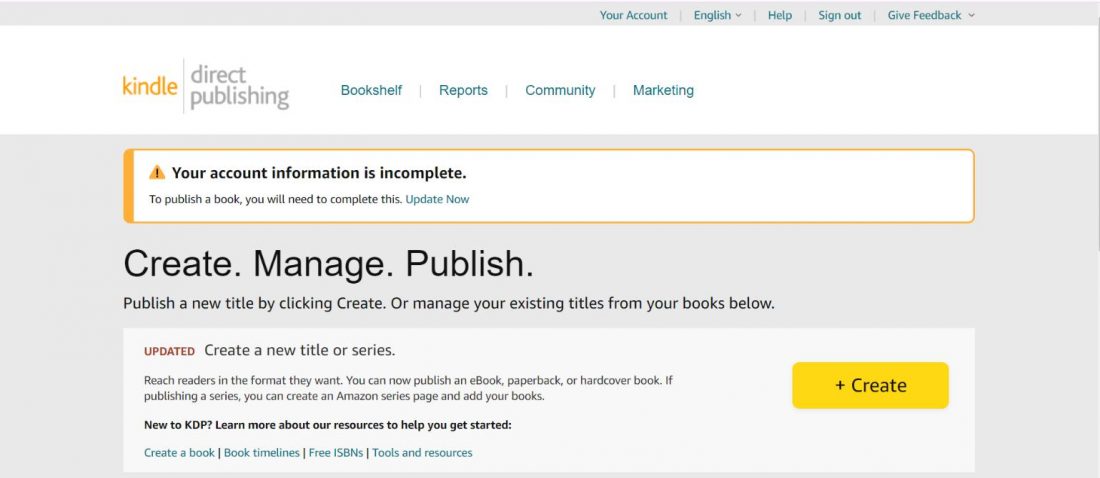
How to Sell Ebooks on Amazon KDP:
- Use the Kindle Direct Publishing website (kdp.amazon.com).
- If you already have an account sign in or create a new account.
- Once you’re logged in, you can set up your author profile, add tax information, and create a new eBook by providing details like the book title, description, and cover image.
- Format your ebook according to KDP guidelines.
- Create an eye-catching cover to attract potential readers.
- Set a competitive price and distribution option, and you’re ready to publish your eBook to the Kindle Store.
- Promote your ebook through social media, email newsletters, and other online channels.
What are the Pros and cons of KDP
Pros of KDP
- Easy Publishing Process: Using Amazon’s Kindle Direct Publishing (KDP) eliminates the need for traditional publishing processes, such as finding literary agents or publishers. This makes it straightforward to get your book out to readers.
- Creative Control: Through KDP, authors maintain complete control over their content, cover design, pricing, and target audience. This creative freedom empowers authors throughout the publishing journey.
- Higher Royalties: Amazon KDP offers more favorable royalty rates compared to conventional publishing models. Authors can earn up to 70% royalties for eBooks priced between $2.99 and $9.99, boosting potential earnings.
- Global Reach: Using Amazon’s expansive reach, digital products have the opportunity to reach a diverse global audience effortlessly. By extending the market scope, revenue potential can be enhanced without adding any additional efforts.
- Marketing Support: Amazon provides various marketing tools, such as Kindle Countdown Deals and Amazon Kindle Advertising, to enhance exposure and drive sales for digital products. These tools can help maximize visibility and attract potential buyers.
- Real-Time Data: Authors using KDP gain access to real-time sales reports and royalties information. This invaluable insight enables informed decision-making based on customer behavior and market trends, facilitating strategic adjustments for optimized performance.
Cons of KDP
- Exclusivity Restriction: Participation in KDP requires an exclusivity clause, which allows authors to distribute their eBooks exclusively through Amazon. This restriction limits the distribution of your work on alternative platforms.
- Commission Structure and Fees: Amazon charges commissions averaging around 15% on earnings from digital products, potentially rising to 45%, which may impact overall profitability for authors.
- Limited Access to Customer Data: Selling on Amazon may restrict authors’ access to buyer information, hindering direct engagement for future marketing efforts and relationship building.
- Market Competition: To distinguish products from their competitors in the Amazon marketplace, companies must invest in significant marketing efforts. The heightened competition poses challenges, especially for lower-priced digital products, which could affect profitability.
2. Digital Art
If you are a graphic designer or an artist with a unique piece of art, then you can post it on Amazon. Amazon Merch is a print-on-demand service that will allow you to sell your artwork. With Amazon’s Merch on Demand, you can see your work printed on a t-shirt, mugs, bags, or pillows. Also, keep in mind that, Amazon Merch is an invite-only program.
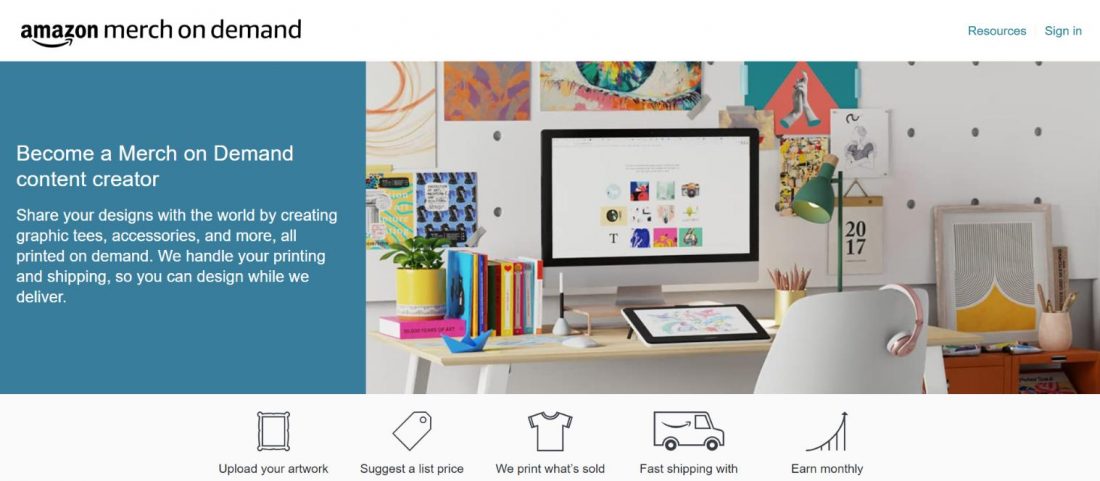
How Amazon’s Merch on Demand works:
- You need to create art or design.
- Upload your artwork on Amazon Merch and pick the product on which you want to create your design.
- Set the price for your product and click ‘Publish’ to make it public.
- Amazon takes care of the rest. They print, ship, and also handle the custom products as they are sold.
- You can collect your royalties after the sale.
Pros and Cons of Merch by Amazon
Pros of Merch by Amazon
- No Initial Costs: Amazon Merch enables sellers to upload merchandise designs for free, eliminating concerns about inventory, printing, or shipping expenses. This allows creators to commence selling their designs without financial obstacles.
- Automated Printing: Amazon nearly automates the printing process for sellers, simplifying production and fulfillment tasks associated with managing a t-shirt business. This automation saves time and reduces the complexity typically involved in independent operations.
- Global Audience: Using Amazon’s platform grants access to a vast global audience, enabling sellers to reach customers worldwide without extensive marketing efforts or infrastructure investments.
- Creative Control: Sellers maintain authority over their designs, pricing, and target audience on Amazon Merch. This empowers them to showcase their unique creations and establish a distinctive brand identity amidst competition.
Cons of Merch by Amazon
- Intense Competition: The low entry barrier results in intense competition on Amazon Merch, as numerous sellers regularly upload designs. This makes it challenging for new sellers to gain visibility and generate sales quickly.
- Invitation Requirement: Amazon Merch operates on an invitation-only basis, necessitating approval before sellers can sell on the platform. This process restricts immediate access for all sellers, potentially delaying market entry.
- Limited Sales Influence: Sellers may face limitations in building direct customer relationships or differentiating themselves from competitors on the platform. This limitation impacts their ability to establish brand loyalty or communicate unique selling propositions effectively.
- Sales Fluctuations: Sellers on Amazon Merch may experience periods of zero sales despite uploading designs, posing a risk of inconsistent revenue streams. Persistence and long-term commitment are essential to achieve success in this competitive marketplace.
3.Music
Musicians can distribute their music digitally on TuneCore, which is a part of Amazon Music.
This platform is provided to customers interested in music downloads and streaming services. TuneCore offers artists the opportunity to showcase their albums, singles, and playlists to a global audience of music enthusiasts.
Artists can earn royalties from music sales, allowing them to construct their musical creations. Also, TuneCore allows them to upload their songs and make them available for stores such as Amazon, Spotify, and 150+ other locations.
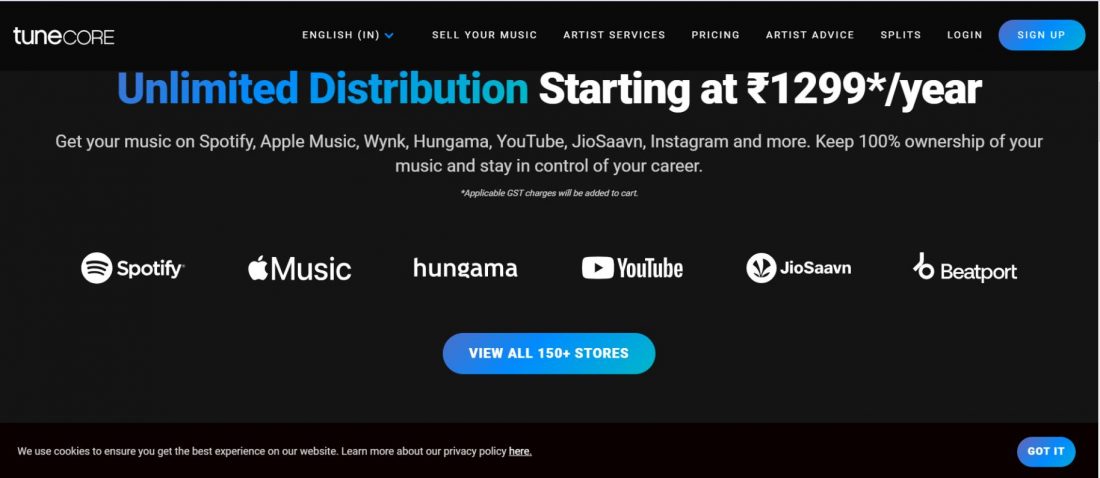
How TuneCore works:
- Artists can register with TuneCore and upload their music onto the platform.
- TuneCore simplifies the distribution process by acting as a middleman, allowing artists to upload their music directly to TuneCore’s platform.
- The service manages tasks such as file encoding and delivers them to more than 150 digital music stores and streaming services, including popular platforms like Amazon Music, Spotify, iTunes, and Google Play.
Pros and cons of TuneCore
Pros of TuneCore
- Broad Distribution: TuneCore distributes music to over 150 digital platforms, including major players like Spotify, Amazon Music, and Apple Music, giving artists extensive exposure to a global audience.
- Full Royalties: Artists can keep 100% of their music royalties when using TuneCore, maximizing their earnings from sales without sharing a portion with the platform.
- Analytics Dashboard: TuneCore provides artists with an analytics dashboard to monitor their sales, earnings, and performance metrics, offering valuable insights for optimizing their distribution strategy.
- Additional Services: Apart from distribution, TuneCore offers supplementary services such as music publishing administration and sync & master licensing, expanding artists’ opportunities for exposure and revenue.
- Diverse Content Options: TuneCore supports the distribution of various content types, including music videos and ringtones, providing artists with a comprehensive platform to showcase their work across different mediums.
Cons of TuneCore
- Annual Fees: TuneCore charges artists an annual fee per album or single distributed, which can add up as a recurring cost over time.
- YouTube Commission: TuneCore deducts a percentage (20%) from artists’ earnings on YouTube, impacting the total revenue earned through this channel.
- Lack of SoundExchange Integration: Unlike some competitors, TuneCore does not integrate with SoundExchange, potentially limiting opportunities for artists to collect royalties from digital radio services.
- Higher Pricing: Compared to alternatives like DistroKid, TuneCore’s pricing plans are relatively higher, which may affect the overall cost-effectiveness for independent musicians.
4. Application and Games
Developers can sell apps, games, and software on Amazon’s platform and earn a good amount on Amazon.
Whether it’s mobile apps, PC games, or productivity software, developers can reach a wide audience of consumers through Amazon. Even though the app is already uploaded to Google Play. You can also get 70% of the gross revenue by selling it on Amazon. Certainly, it is less than what you can get from selling it on your website.
Amazon’s Appstore provides developers with tools and resources to market their apps effectively and generate revenue through app sales and in-app purchases.
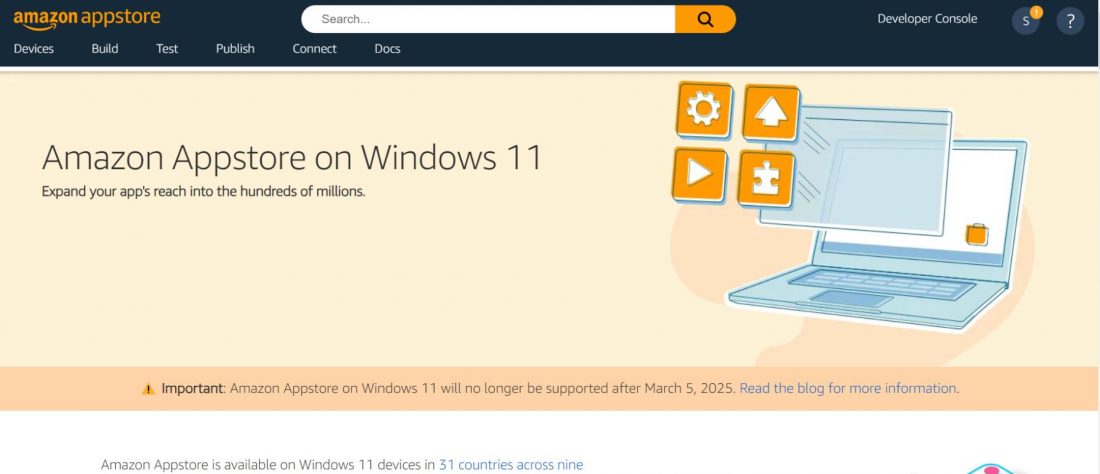
How Amazon Appstore works:
- Create an Amazon Developer Account on the Amazon Developer website.
- Develop your application or game according to Amazon’s guidelines and policies.
- Upload Your Application or Game files
- Choose the pricing model for your application or game, whether it’s free, paid, or includes in-app purchases.
- Submit your application or game for review by Amazon’s Appstore team.
- Utilize Amazon’s marketing tools and services to promote your application or game.
Pros and cons of Amazon Appstore
Pros of Amazon Appstore
- Better Descriptions and Comments: The Amazon App Store provides more in-depth descriptions and detailed comments, making it easier for users to find quality apps and make informed decisions.
- Free Premium App of the Day: Amazon offers free premium apps like Angry Birds Rio and Swiftkey Keyboard, providing users with valuable content at no cost.
- Test Drive Feature: Users can “test drive” apps within their browser, allowing them to experience the app before making a purchase decision, enhancing user experience, and reducing uncertainty.
- Exclusive Apps: The Appstore offers exclusive apps, creating a sense of exclusivity and potentially attracting users who seek unique content not available elsewhere.
Cons of Amazon Appstore
- No Return Policy: The Amazon Appstore lacks a return policy, which can be a drawback for users who may want to return apps after a purchase.
- Installation Process: The installation process on the Amazon App Store is considered more annoying compared to other platforms, potentially leading to a less user-friendly experience.
- Limited Availability: The Appstore is not available on AT&T devices and in countries outside the US, limiting its reach to a global audience.
- Exclusive Apps Limitation: While exclusive apps can be enticing, they may restrict users who are not on AT&T or located outside the US from accessing certain content, potentially limiting the user base.
5. Digital Courses
Educators and content creators can market online courses and tutorials on Amazon, targeting individuals seeking knowledge and skill development. You can sell online courses with Amazon’s Video Direct.
With Amazon’s Video Direct, you can sell, rent, or even offer it for free. From language courses, and training courses to professional certifications, Amazon offers Amazon Video Direct for educators to share their expertise and monetize their educational content.
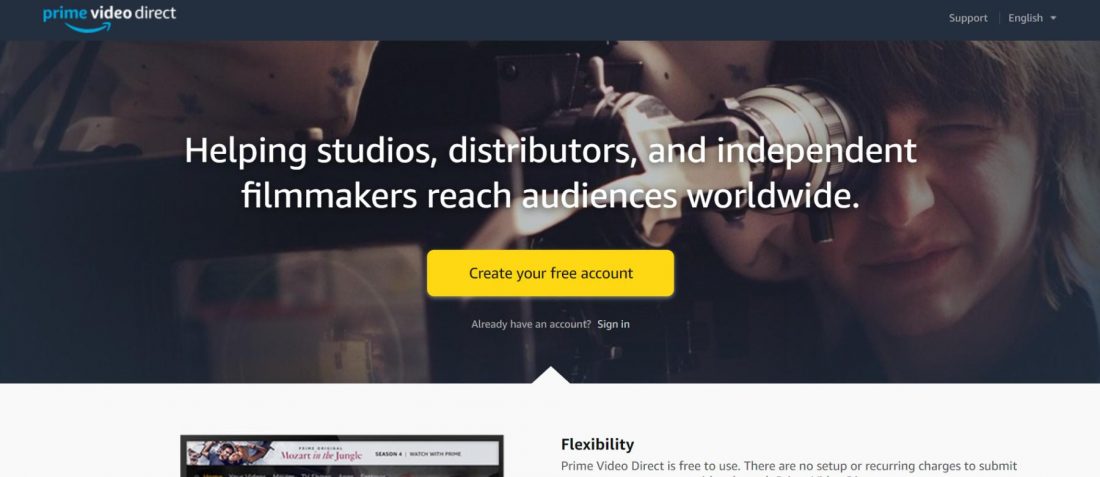
How Amazon Video Direct works:
- First, convert your course into video format. Ensure it complies with Amazon’s guidelines.
- Then set up an Amazon seller account to begin selling your digital videos on Amazon Video Direct.
- Navigate to the appropriate section on Amazon’s site, such as Amazon Seller Central or Prime Video Direct, and sign a contract with Amazon to start selling your videos.
- Once you have your video content ready, upload it to Amazon Video Direct. You can use services like Zapier to facilitate the integration with platforms like Teachable or Thinkific for course delivery.
- Treat your course like any other product on Amazon by creating a compelling product listing, promoting it, and working to attract customers to your course.
Pros and cons of Amazon Video Direct
Pros of Amazon Video Direct
- Low-Cost Entry: Amazon Video Direct provides a low-cost option for self-distributors, allowing filmmakers to distribute their content without significant upfront expenses.
- Revenue Opportunities: Creators can earn royalties through various legalization options like rentals, purchases, and ad-supported content, providing revenue flexibility.
- Access to Prime Audience: Content included with Amazon Prime is automatically eligible for the Amazon Video Direct Star Bonus, offering an additional revenue opportunity for creators with popular titles.
- Metrics and Analytics: Amazon Video Direct provides creators with metrics like hours viewed, allowing them to measure the effectiveness of their promotional and marketing strategies.
- Global Reach: Amazon Video Direct allows creators to showcase their content to a wide audience, potentially reaching millions of Amazon Prime subscribers in select countries.
Cons of Amazon Video Direct
- Limited Territories: Currently, Amazon Video Direct is only supported in a few countries like the US, UK, Germany, and Japan, limiting the global reach of content creators.
- Competition with YouTube: While Amazon Video Direct offers revenue flexibility, YouTube still holds advantages with a larger global audience and more transparent subscription rates, making it a strong competitor.
- Entry Barriers: Amazon Video Direct has significant entry barriers to weed out non-professional creators, including requirements like tax forms, bank account details, and caption files for all videos.
- Payment Cap: Amazon Video Direct has a payment cap, which may send the wrong message to creators and limit revenue potential compared to platforms like YouTube with no payment cap.
- Limited Discoverability Features: Currently, Amazon Video Direct lacks certain discoverability features like suggested video autoplay, which could impact the visibility and popularity of content.
6. Audiobook
Audiobooks are a popular form of digital content and can be distributed through Amazon’s platforms like Audible, which is owned by Amazon.
Authors and publishers can upload their audiobooks to Audible for sale to customers who prefer listening to books rather than reading them. Selling audiobooks on Amazon provides creators with access to a large and diverse audience, allowing them to monetize their content and reach listeners worldwide.
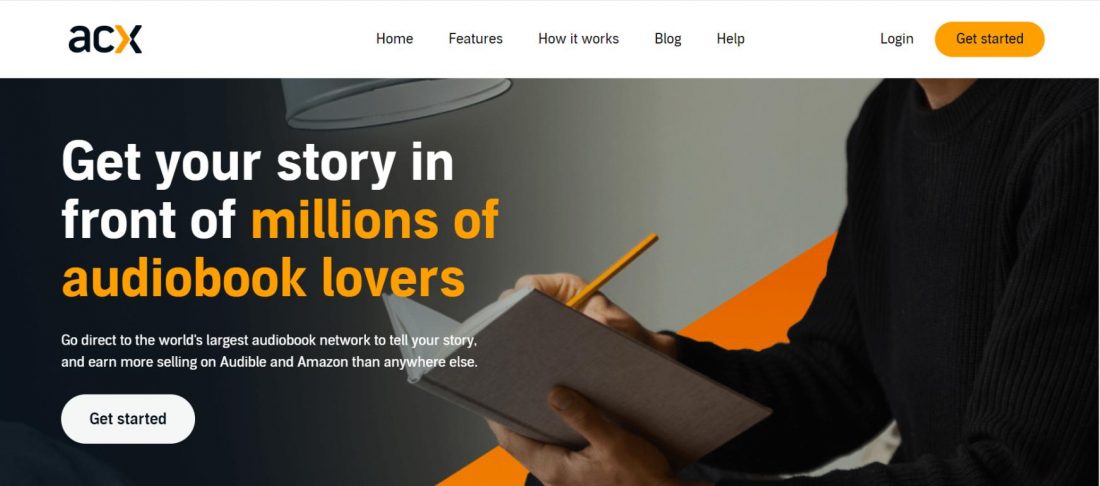
How Audible works?
- Create an Account on ACX (Audiobook Creation Exchange)
- Click on “Start My Audiobook” on ACX and complete the necessary steps, including setting up payment information and tax details.
- Choose the book you want to turn into an audiobook. The book must already be available on Amazon as a print or ebook.
- Decide whether you have audio files ready that meet Amazon’s standards or if you need to find a narrator and producer for your audiobook.
- Choose territories and distribution terms.
- Specify the territories where you have rights to publish and distribute your audiobook.
- Carefully review the terms and conditions before accepting them to ensure you understand the distribution rights and royalties involved.
- Describe your audiobook, adjust your book description, and input any necessary copyright information.
- Upload your audio files by chapter, fill in chapter names, upload your audiobook cover, and any additional files like credits.
- ACX will review your project, and if everything meets the requirements, it will be approved and made live on the site.
- Complete your account settings by providing the necessary details about your payment method and tax information before you can start selling your audiobook on Amazon Audible.
Pros and cons of Amazon Audible
Pros of Amazon Audible
- Huge Library: Amazon Audible offers access to over 200,000 audiobooks, making it the largest audiobook library globally.
- Audible Originals: Members receive two Audible Originals every month, exclusive audio materials created by famous journalists or writers, enhancing the listening experience.
- Great for Commuters: Audible is a perfect companion for commutes or daily errands, offering a vast selection of audiobooks to choose from, catering to avid readers and listeners.
- Easy Return Policy: Audible allows users to return audiobooks within 365 days of purchase or exchange them for a different one, ensuring customer satisfaction and flexibility.
- High-Quality Narration: Most audiobooks on Audible are narrated by experienced professionals like Michelle Obama and Stephen Fry, providing superior voice quality and enhancing the listening experience.
- Compatibility: Audible is compatible with various devices, including smartphones, tablets, Kindle, and Amazon Alexa, allowing users to listen to audiobooks anytime, anywhere.
- WhisperSync Feature: This unique feature syncs listening sessions with e-reading devices, enabling a seamless transition between audio and e-book formats, and enhancing convenience for users.
Cons of Amazon Audible
- Cost: Audible has a monthly fee of $14.95, which may be considered expensive compared to other audiobook services, especially if not utilizing the credits effectively.
- Credit System: Users need to manage credits effectively as they expire if the subscription is canceled, potentially leading to a waiting period for new books or additional costs.
- Limited Free Access: While Audible offers a 30-day free trial, the free content is limited, and after the trial ends, users must choose between paying full price for audiobooks or opting for a subscription plan.
- Inability to Buy Directly from App: Users cannot purchase books directly from the Audible app, which may be inconvenient for some readers who prefer a more streamlined purchasing process.
Benefits of Selling Digital Products on Amazon?
There are numerous benefits of selling digital products on Amazon, which are:
1. Low Initial Investment
Selling digital goods on Amazon typically demands minimal upfront investment. Unlike physical products, which will have manufacturing, storage, and shipping expenses, digital products often require fewer overhead costs. This makes it an attractive option for individuals or small businesses with limited budgets.
2. High-Profit Margins
Digital products tend to give high-profit margins due to their replicability and low production costs. While Amazon may impose selling fees, the absence of manufacturing, shipping, and inventory expenses contributes to a larger proportion of revenue converting into profit.
3. Positive Customer Interaction
With its vast and diverse customer base, Amazon provides an opportunity to engage with a wide audience. Customer reviews and ratings enhance product visibility and credibility, fostering potential sales and customer loyalty.
4. Efficient Management and Delivery
Digital products can be managed and delivered quickly and efficiently. Upon purchase, customers can instantly download or access their product, ensuring a seamless and satisfying experience. This immediacy contributes to positive customer interactions.
5. Zero Inventory Costs
Unlike traditional retail products, selling digital products on Amazon eliminates the need for physical inventory. Digital goods are stored electronically, reducing the burden of warehouse management, logistics, and associated expenses.
While the benefits of selling digital products on Amazon are clear, achieving success may necessitate effective marketing, customer support, and adherence to Amazon’s policies.
In the next section, you can understand what steps to take to be profitable by selling digital products on Amazon.
How to Be Profitable By Selling Digital Products on Amazon?
Selling digital products on Amazon can be a profitable venture if you approach it strategically.
Here’s a step-by-step guide on how to be profitable by selling digital products on Amazon:
1.Identify the Niche
Identify a niche or target market where there is demand for digital products. Analyze the competition and ensure there is a viable audience for your products.
Also, choose a niche that aligns with your passion or expertise. This will not only make product creation more enjoyable but also help you understand the needs of your target audience better. To make your process more simpler, consider using SellerApp Chrome Extensions. This tool will help you analyze the market trends and help you identify the profitable products within your chosen niche.
2. Create High-Quality Products
Ensure that your digital products are of high quality and provide value to customers. Whether it’s an eBook, software, or other digital content, delivering excellence will contribute to positive reviews and customer satisfaction.
If applicable, invest in professional design for your digital products. A visually appealing and well-designed product can enhance its perceived value.
3. Optimize Your Product Listing
Use relevant keywords in your product title, description, and backend search terms. This will improve the discoverability of your digital products when customers search on Amazon.
Also, make sure that you use high-quality images or graphics to showcase your digital products. These high-quality images play an important role in optimizing your product listing and in attracting potential buyers.
4. Take Advantage of Customer Reviews
Encourage customers to leave reviews by providing excellent customer service and follow-up. Positive reviews build trust and credibility.
If customers encounter problems or add negative reviews, address them promptly and professionally. This not only resolves immediate concerns but also demonstrates your commitment to customer satisfaction.
5. Use Amazon Ads
Utilize Amazon’s advertising platform to run sponsored product ads. This can increase visibility and attract more potential buyers to your digital products.
You can set up targeted advertising campaigns based on relevant keywords, interests, or demographics to reach your ideal audience.
6. Give Promotions
Offer limited-time promotions or discounts to incentivize initial sales. This can generate initial traction and attract more customers.
Additionally, consider bundling related digital products together for a special price. This can increase the value for customers.
By following these steps and adapting your strategy based on the above points, you can increase the profitability of your digital products on Amazon.
Conclusion
A successful digital marketplace demands continuous adaptation and innovation. The landscape of selling digital products on Amazon is constantly changing, so sellers who remain on top of industry trends, embrace customer feedback, and refine their strategies accordingly will succeed going forward.
Additional read:
Proven Amazon Seller Promotion Techniques to Increase Your CTR
Ultimate Guide on Amazon Kindle Direct Publishing (KDP)
Amazon Seller Software: Discover the 9 Best Tools to Help You Dominate Your Category


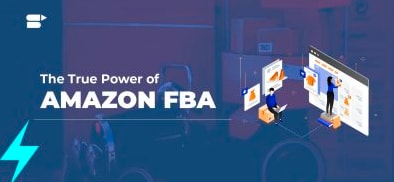
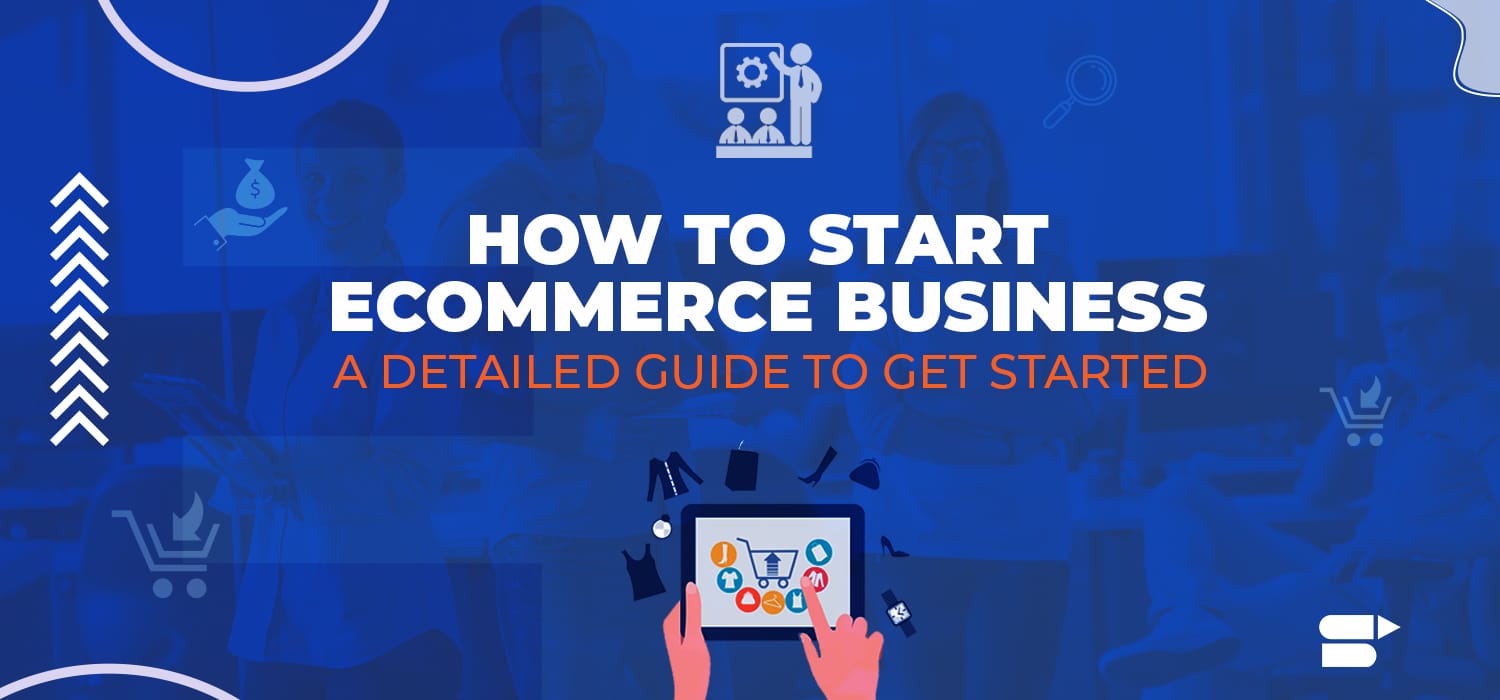

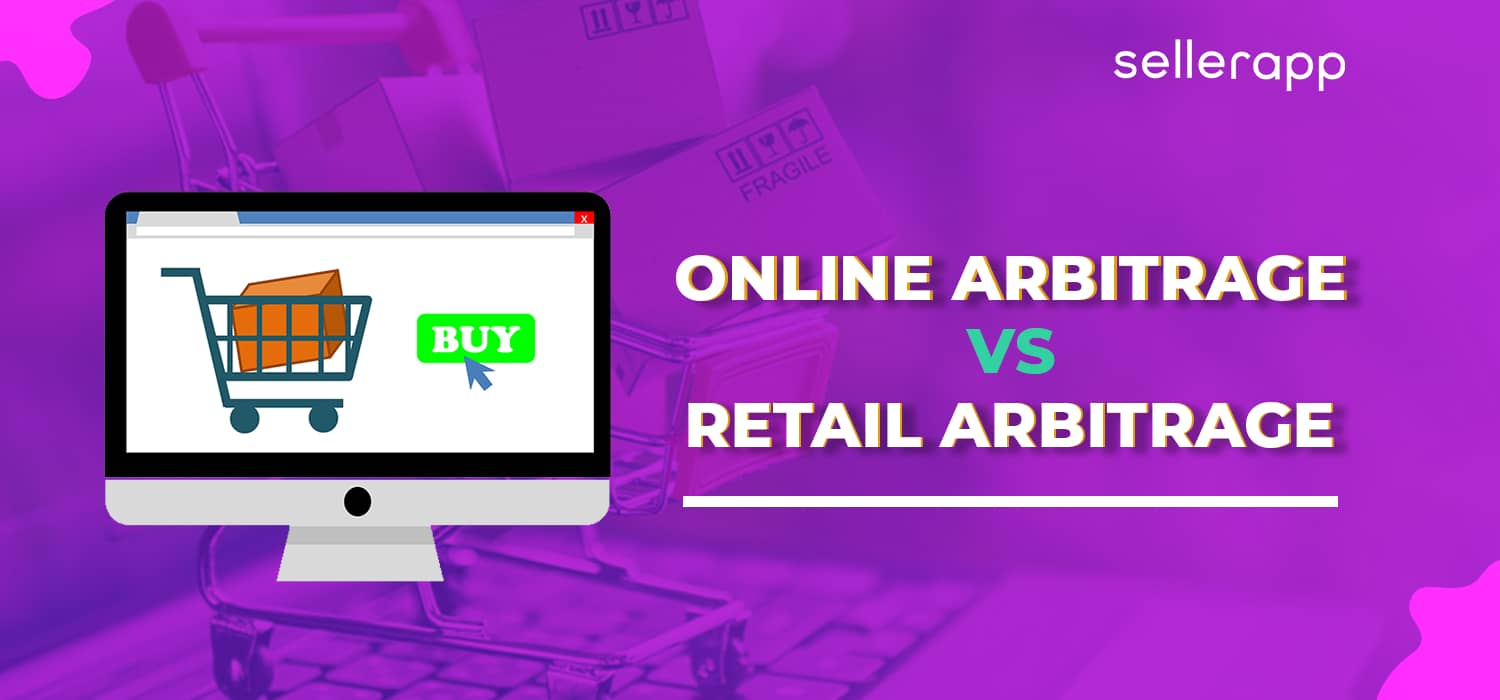
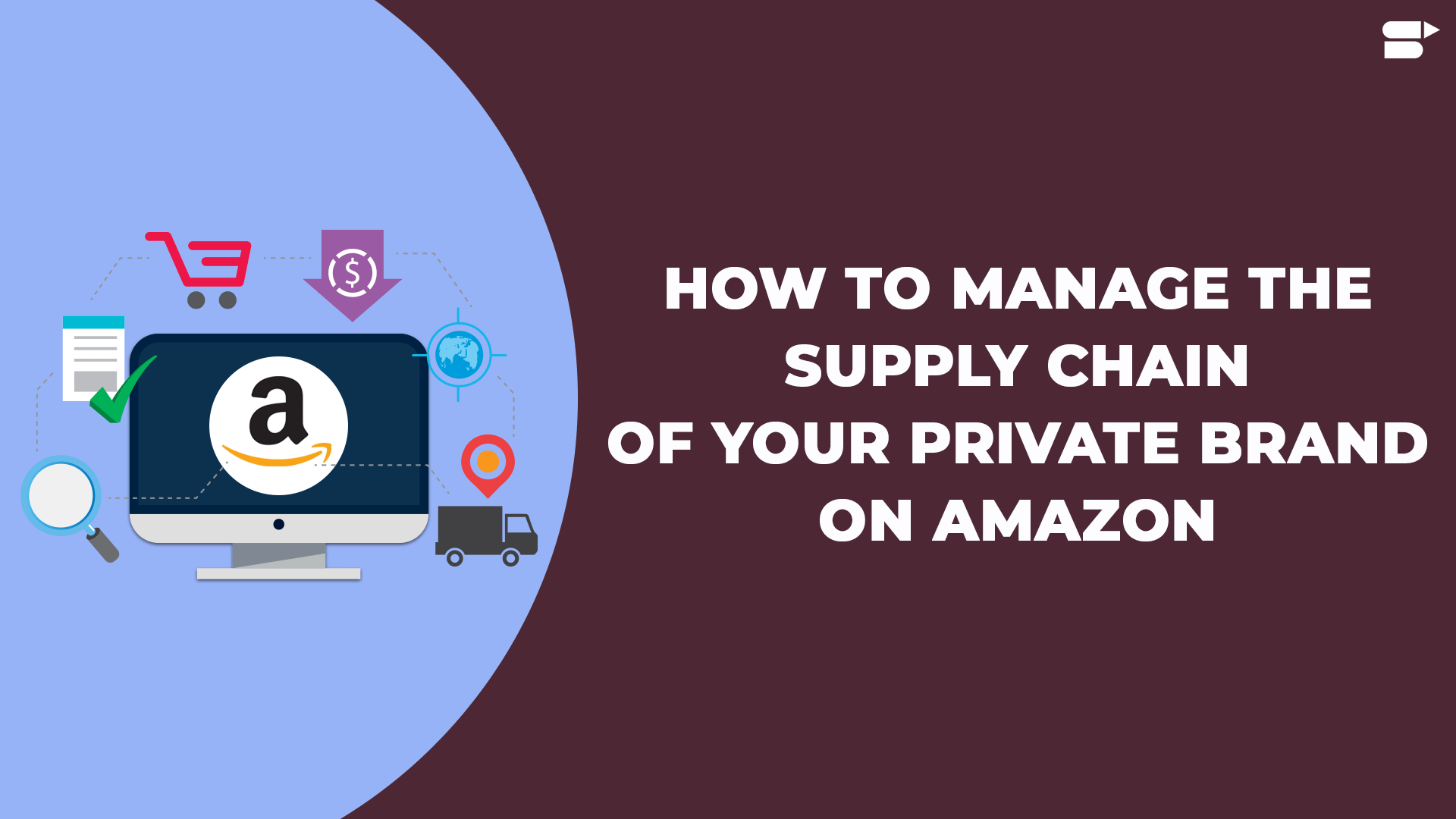
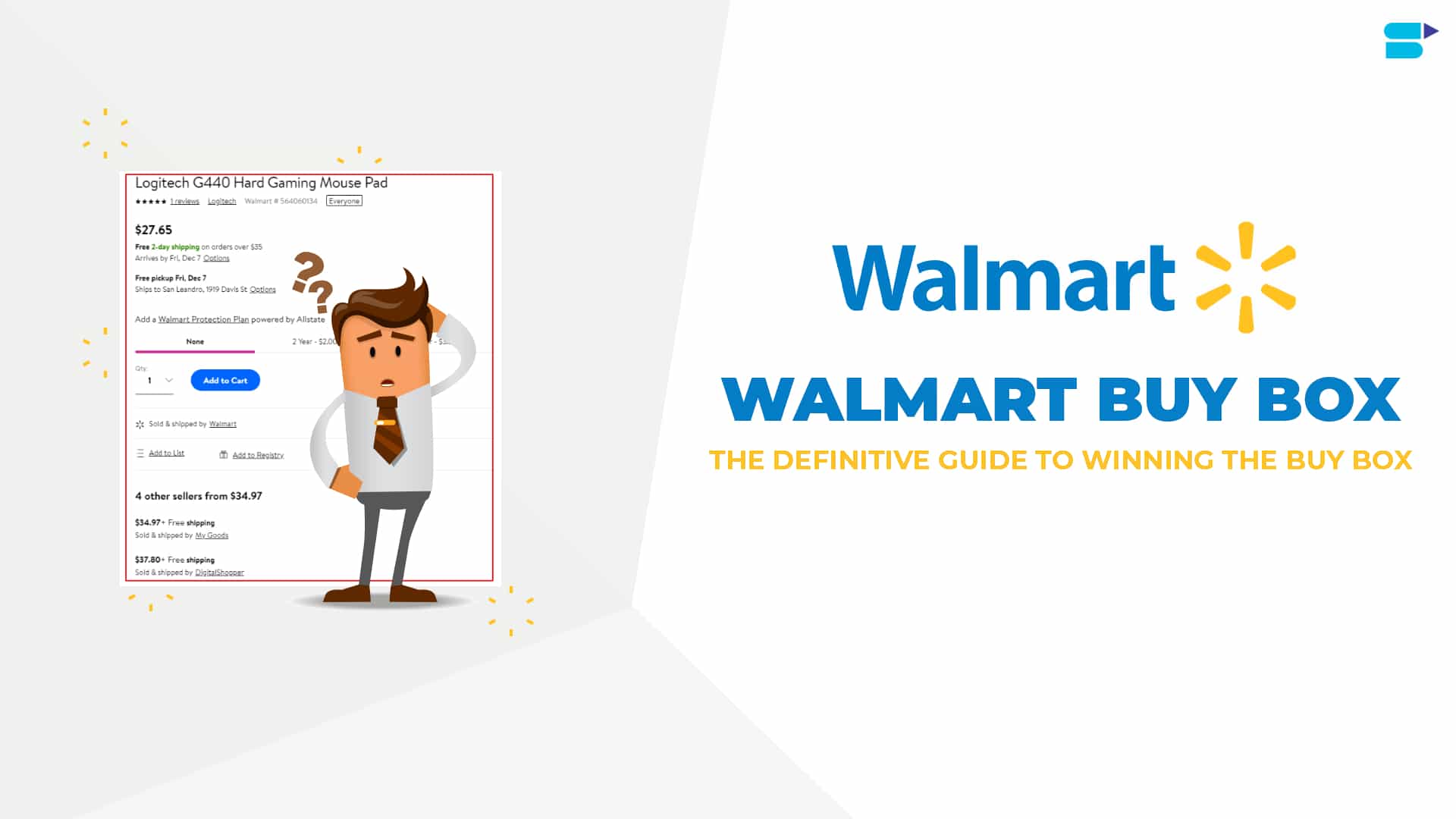
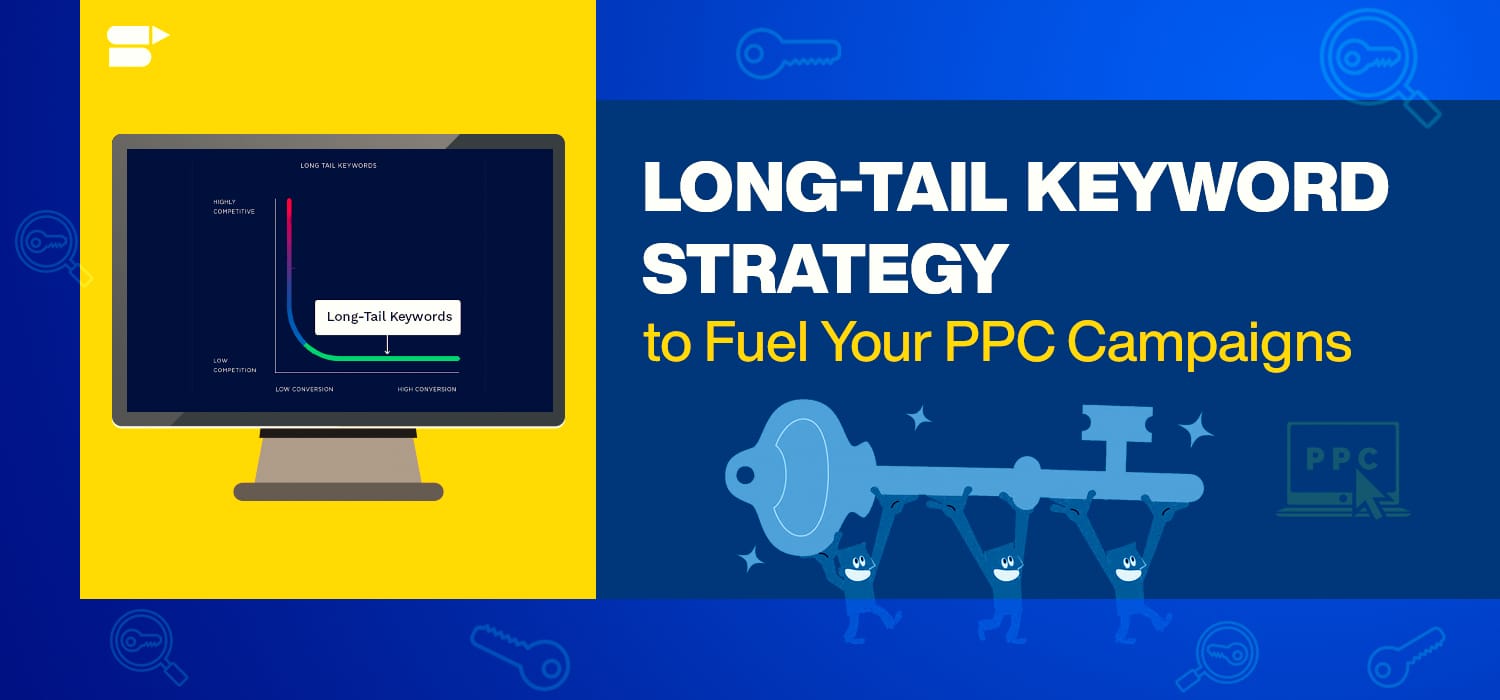

Vance Rogers
May 3, 2024I found this blog post on selling digital products on Amazon extremely helpful. It covers all the necessary information concisely.
Clare Thomas
July 30, 2024Thanks for the positive feedback!